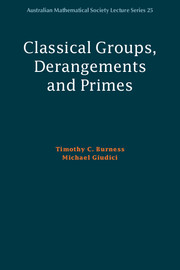Book contents
Preface
Published online by Cambridge University Press: 18 December 2015
Summary
The theory of permutation groups is a classical area of algebra, which arises naturally in the study of symmetry in a vast range of mathematical and physical systems. Originating in the early nineteenth century, permutation group theory continues to be a very active area of current research, with far-reaching applications across the sciences and beyond. In the last thirty years, the subject has been revolutionised by the Classification of Finite Simple Groups (CFSG), a truly remarkable theorem that is widely recognised as one of the greatest achievements of twentieth century mathematics. This has led to many interesting problems, and the development of powerful new techniques to solve them.
Let G be a transitive permutation group on a finite set Ω of size at least 2. By a classical theorem of Jordan [82], G contains an element that acts fixed-point- freely on Ω; such elements are called derangements. The existence of derangements has interesting and unexpected applications in many other areas of mathematics, such as graph theory, number theory and topology (we will briefly discuss some of these applications in Chapter 1).
The study of derangements can be traced all the way back to the origins of probability theory over three centuries ago. Indeed, in 1708 Pierre de Mont-mort [106] studied the proportion of derangements in the symmetric group Sn in its natural action on n points. Montmort obtained a precise formula, which shows that this proportion tends to the constant 1/e as n tends to infinity. This work played an important role in his pioneering mathematical analysis of various games of chance that were popular in the salons and gambling dens of early eighteenth century Paris. As we will see in Chapter 1, a wide range of related problems concerning derangements has been studied in more recent years.
One of the main motivations for our work stems from a theorem of Fein, Kantor and Schacher that provides a powerful extension of Jordan's aforementioned existence result. The main theorem in [52] states that every transitive group G as above contains a derangement of prime power order. It is interesting to note that the only known proof of this theorem requires CFSG. Naturally, we can ask whether or not G always contains a derangement of prime order.
- Type
- Chapter
- Information
- Classical Groups, Derangements and Primes , pp. xi - xvPublisher: Cambridge University PressPrint publication year: 2016

